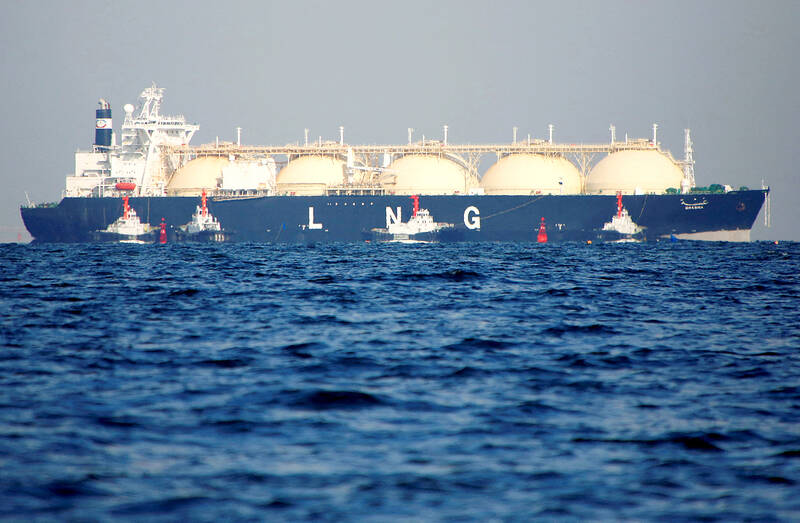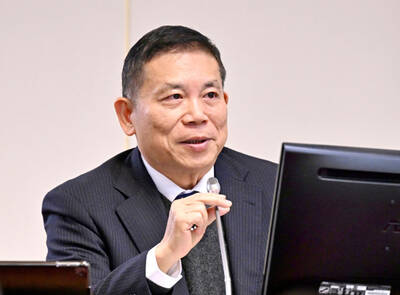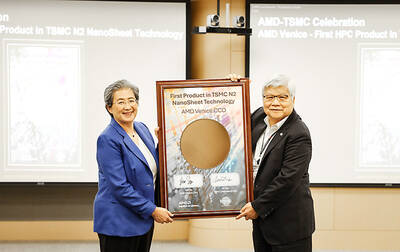When US President Donald Trump sat down to lunch with his Japanese counterpart on Feb. 7, talk turned quickly to how Tokyo could help realize a decades-old proposal to unlock gas in Alaska and ship it to US allies in Asia.
Trump and his energy czar — US Secretary of the Interior Doug Burgum — framed the venture as a way for Japan to replace Middle East energy shipments and address its trade imbalance with the US, two officials briefed on the closed-door talks said.
Japanese Prime Minister Shigeru Ishiba — eager to ensure a positive first meeting and stave off damaging US tariffs — struck an optimistic note about the Alaska liquefied natural gas (LNG) project, despite Tokyo’s doubts about its viability.

Photo: Reuters
Ishiba told Trump and Burgum that he hoped Japan could participate in the US$44 billion project, said the officials, granted anonymity due to the sensitivity of the talks.
Trump repeatedly mentioned the project in his public remarks after the lunch. Ishiba did not, and there was no reference to it in the official readout of the talks.
Reuters interviews with more than a dozen people, including current and former US and Asian officials, show how the Trump administration is moving to recast economic relations with East Asia by binding regional allies to Washington through increased investment in US fossil fuels, particularly LNG.
The US sales pitch seeks to tap into concerns in Asian capitals about tariffs and the security of sea lanes that carry their energy imports, Reuters found.
Details of the behind-the-scenes exchanges and specifics of the US approach have not been previously reported.
While the Alaska LNG proposal faces cost and logistical hurdles, Japan, South Korea, Taiwan and others are buying into the idea of increasing US gas imports more broadly, which could bolster the US economy and blunt the influence of China and Russia.
Japan’s participation in Trump’s emerging strategy would be critical: It is the world’s No. 2 LNG buyer, a major investor in energy infrastructure, and a trading hub with a glut of LNG that could help open new markets for US gas in Southeast Asia.
“If the Trump administration were to have its way, US LNG would flow in massive quantities to Japan and South Korea and then would flow downstream ... so that Southeast Asia would become economically dependent on the United States,” said Kenneth Weinstein, Japan chair at Hudson Institute, a conservative think tank. “It’s redrawing the map of energy dependence.”
In a joint statement with US Secretary of State Marco Rubio on Saturday last week, Japanese and South Korean foreign ministers agreed to strengthen energy security by “unleashing” the US’ “affordable and reliable energy,” particularly LNG. They did not mention Alaska.
White House National Security spokesman Brian Hughes said the US “produces some of the cleanest LNG in the world and we believe the Japanese can play an even bigger role in purchasing America’s abundant oil and gas.”
The Japanese Ministry of Foreign Affairs declined to comment on the accounts of the Ishiba-Trump meeting.
Japan’s trade minister plans to visit Washington next month to seek exemptions from Trump’s tariffs and discuss Japan’s plans to buy more US LNG, Japanese media reported on Thursday.
The idea of building a 1,300km pipeline linking gas fields on Alaska’s North Slope to an export terminal on its Pacific coast has long stuttered due to the high costs and harsh terrain.
However, expecting Trump might raise a project he has personally championed in the meeting with Ishiba, Japan was preparing to voice tentative support to win his favor and forestall trade friction, Reuters reported last month. They did not anticipate it would feature so highly on Trump’s agenda.
Over lunch with Trump and Burgum, the US asked Japan to consider infrastructure investments in Alaska LNG as well as long-term purchase agreements, officials briefed on the talks said.
The US side stressed the project’s proximity to Japan compared with the Middle East and the fact that shipments would avoid sensitive choke points, such as the Straits of Hormuz and Malacca, and the South China Sea, the officials said.
Additional purchases of US LNG could also help Asian allies reduce reliance on Russian gas, US Senator Dan Sullivan of Alaska.
Alaska LNG “was a big part of the discussion” with Ishiba, Sullivan, who was briefed on the talks, told Reuters.
At one point in the meeting, the US officials used maps to emphasize the strategic benefits of the Alaska project, Sullivan and another official said.
Project developers are trying to court investment from firms such as Inpex, a Tokyo-listed oil and gas exploration company whose largest stakeholder is the Japanese government, two other sources said.
A spokesperson for Inpex, which has not been previously linked to the Alaska plan, said it would not comment on “discussions or dealings with specific stakeholders.”
Japan obtains about one-10th of its LNG from the US, and similar proportions from Russia and the Middle East, according to the Japanese Ministry of Finance. Australia accounts for about 40 percent.
Hiroshi Hashimoto, senior analyst at Japan’s Institute of Energy Economics, said LNG imports from the US could reach 20 percent of Japan’s total over the next five to 10 years as existing contracts, including with Russia, roll off.
US LNG is largely shipped to Japan from the Gulf of Mexico, which Trump recently renamed to the Gulf of America, via the Panama Canal or the long way around past Africa and through the Indian Ocean.
There are no LNG export terminals on the US west coast — a more direct route to Asia — although Sempra’s Costa Azul project in Mexico, fed by US gas, is expected to start commercial operations next year.
Of the 119.8 billion cubic meters of LNG the US shipped last year, more than one-third went to Asia, according to LSEG data.
Beyond Japan, Trump’s energy security argument seems to be landing elsewhere in Asia, especially with trade tariffs looming. Indian Prime Minister Narendra Modi made a similar gas pledge in a meeting with Trump this month.
Taiwan is also considering more US energy purchases, including LNG from Alaska.
Increasing Taiwan’s dependence on US energy could help deter China from taking aggressive steps such as naval blockades, said Landon Derentz, who was a senior US energy official during Trump’s first term.
With US supplies, “in some ways you’re contracting for a security guarantee that the United States is going to be an advocate in the event of a conflict in making sure that supply arrives,” he said.
South Korea, too, is weighing investing in Alaskan LNG and other US energy projects, two South Korean officials told Reuters.
Seoul hoped for concessions from Trump in return, one said.
A spokesperson for the South Korean Ministry of Trade, Industry and Energy said Seoul was exploring ways to strengthen energy security with the US.
US Senator Bill Hagerty, who served as ambassador to Tokyo in the first Trump administration, said he would like Japan, which already trades its surplus gas, to become the key distribution hub for US-origin LNG.
“Whether it’s from Alaska, Louisiana or Texas, America can work very closely with Japan to create the type of energy security bonds that will be great for our nations’ economies and for our national security,” he said.

UNCERTAINTY: Innolux activated a stringent supply chain management mechanism, as it did during the COVID-19 pandemic, to ensure optimal inventory levels for customers Flat-panel display makers AUO Corp (友達) and Innolux Corp (群創) yesterday said that about 12 to 20 percent of their display business is at risk of potential US tariffs and that they would relocate production or shipment destinations to mitigate the levies’ effects. US tariffs would have a direct impact of US$200 million on AUO’s revenue, company chairman Paul Peng (彭雙浪) told reporters on the sidelines of the Touch Taiwan trade show in Taipei yesterday. That would make up about 12 percent of the company’s overall revenue. To cope with the tariff uncertainty, AUO plans to allocate its production to manufacturing facilities in

Taiwan will prioritize the development of silicon photonics by taking advantage of its strength in the semiconductor industry to build another shield to protect the local economy, National Development Council (NDC) Minister Paul Liu (劉鏡清) said yesterday. Speaking at a meeting of the legislature’s Economics Committee, Liu said Taiwan already has the artificial intelligence (AI) industry as a shield, after the semiconductor industry, to safeguard the country, and is looking at new unique fields to build more economic shields. While Taiwan will further strengthen its existing shields, over the longer term, the country is determined to focus on such potential segments as

TAKING STOCK: A Taiwanese cookware firm in Vietnam urged customers to assess inventory or place orders early so shipments can reach the US while tariffs are paused Taiwanese businesses in Vietnam are exploring alternatives after the White House imposed a 46 percent import duty on Vietnamese goods, following US President Donald Trump’s announcement of “reciprocal” tariffs on the US’ trading partners. Lo Shih-liang (羅世良), chairman of Brico Industry Co (裕茂工業), a Taiwanese company that manufactures cast iron cookware and stove components in Vietnam, said that more than 40 percent of his business was tied to the US market, describing the constant US policy shifts as an emotional roller coaster. “I work during the day and stay up all night watching the news. I’ve been following US news until 3am

COLLABORATION: Given Taiwan’s key position in global supply chains, the US firm is discussing strategies with local partners and clients to deal with global uncertainties Advanced Micro Devices Inc (AMD) yesterday said it is meeting with local ecosystem partners, including Taiwan Semiconductor Manufacturing Co (TSMC, 台積電), to discuss strategies, including long-term manufacturing, to navigate uncertainties such as US tariffs, as Taiwan occupies an important position in global supply chains. AMD chief executive officer Lisa Su (蘇姿丰) told reporters that Taiwan is an important part of the chip designer’s ecosystem and she is discussing with partners and customers in Taiwan to forge strong collaborations on different areas during this critical period. AMD has just become the first artificial-intelligence (AI) server chip customer of TSMC to utilize its advanced